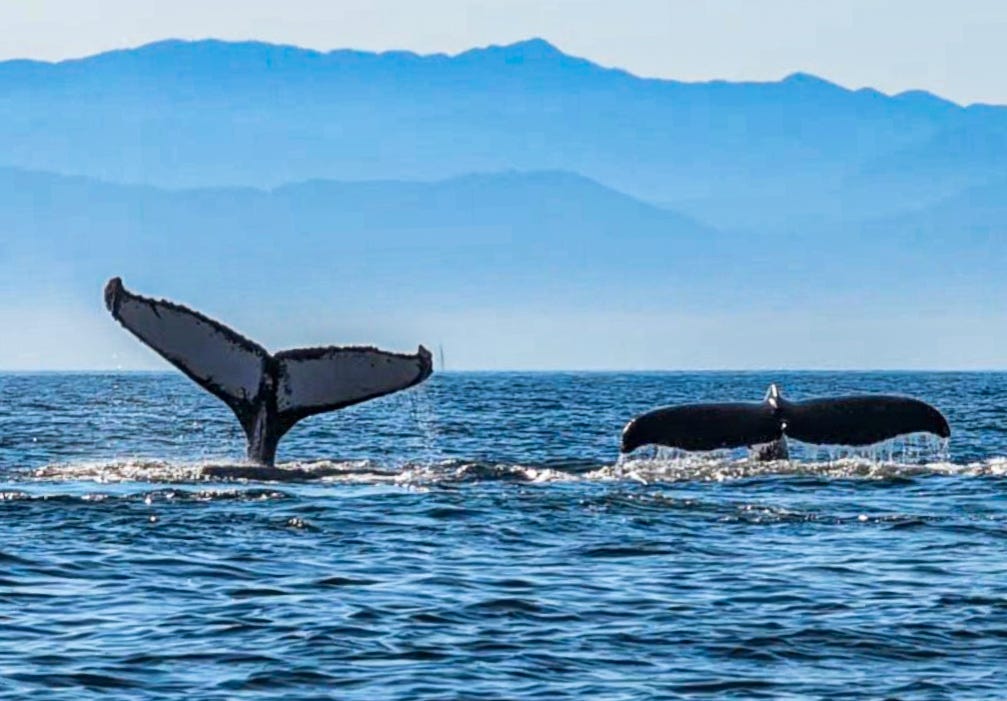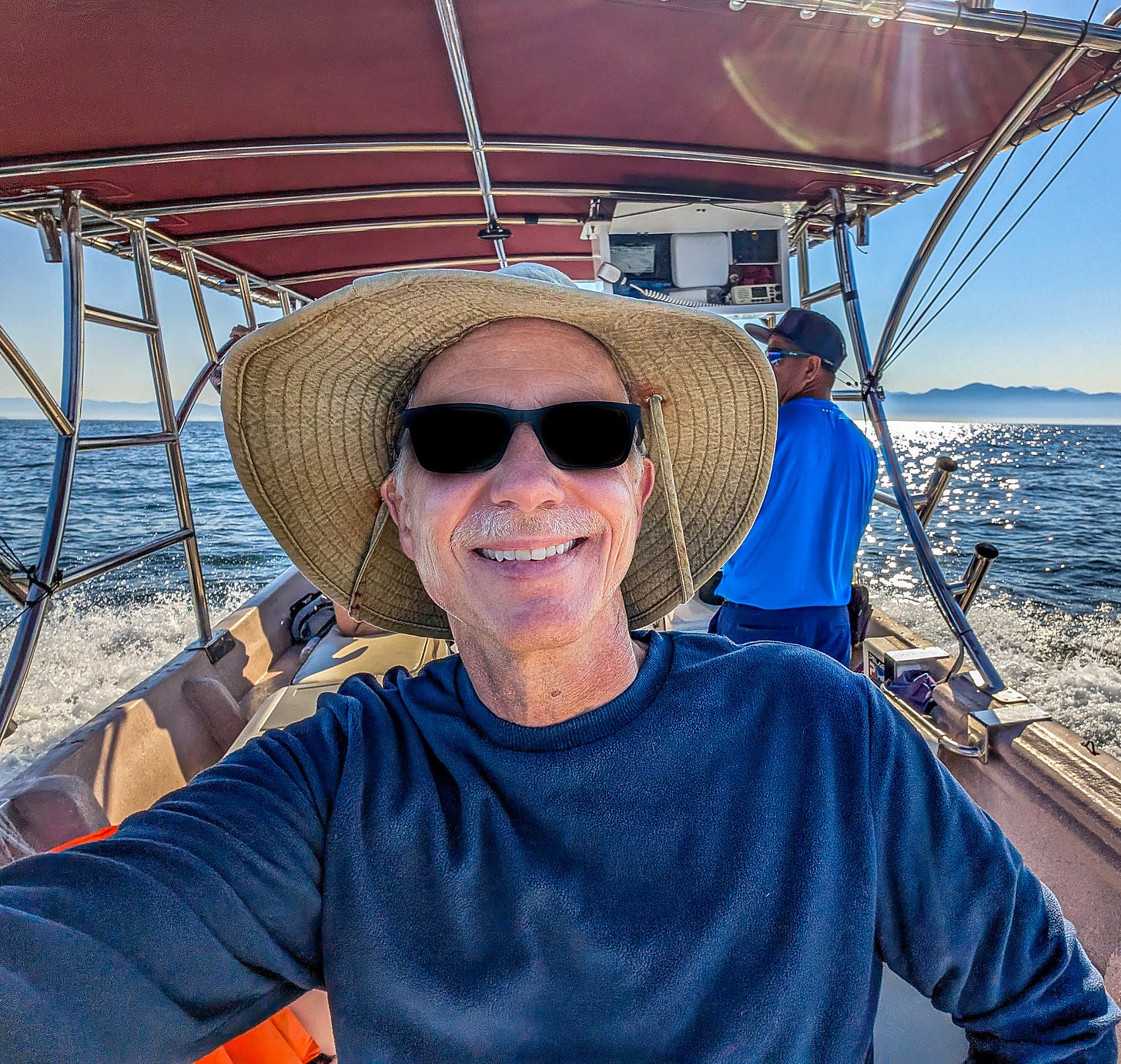Puerto Vallarta is the Winter Home for a Thousand Humpback Whales. I Was Determined to Get the Perfect "Whale" Picture.
Did I succeed?
Every winter, humpback whales make a 3,000-mile journey from the waters of the Arctic, where they feed on krill, to warmer waters down south to mate and calve.
Up to a thousand of those whales end up in Banderas Bay, off the coast of Puerto Vallarta, Mexico.
Which is where Brent and I are living right now. For the last two months, we have been watching from the balcony of our villa as those whales jump and frolic in the bay.
And I’m an amateur photographer. I may have mentioned my love for photography once or twice before?
I love the challenge of finding something beautiful, interesting, or strange — and capturing it forever.
And I desperately wanted a picture of those whales — the perfect picture, if you will.
I wanted one of those iconic photos of a humpback breaching: the full, cinematic leap that graces travel magazines and whale-watching brochures.
So I hired a local wildlife photographer to take me out on the water. This wasn’t one of the big boats crammed with tourists that go to all the usual whale-viewing spots for a few hours. No, it was just me and a few others on a small boat going as far and wide as we needed to — to get as close to those whales as was legally and ethically permissible.
We started early. I arrived at the marina — a half-hour north of Puerto Vallarta — just moments before the sun rose, turning the world a lovely tangerine color.
In addition to Larry, the wildlife photographer, the trip included Ron and Sandy, a couple from Colorado, and Larry’s wife, Krissy.
Upon setting off, we saw whales almost immediately: a mother and her calf surfacing nearby.
Larry explained that humpback calves stay with their mothers for about a year, during which time they learn the skills they’ll need to survive: how to swim, feed, and communicate through vocalizations and by slapping their fins.
On one hand, this was a familiar scene of a mother caring for her young. But my reaction from our first encounter? Whales are alien and mysterious — and big!
Two more adults appeared. The first rolled onto its back, a pectoral fin rising from the water, almost as if saluting us. The fin struck the water with a thunderous boom.
Not long after, we saw still more whales, including two who lifted their tails from the sea together.
Biologists still don’t know precisely why whales slap their fins and tails, but they assume it’s a form of communication — part of a courtship ritual, or a signal to other whales that danger is near. It might also help in the hunt for food.
I quickly snapped a picture.
With all these whales, I was sure it was only a matter of time before I’d get my “perfect” picture of a whale breaching.
We stayed among the whales for over an hour, and Larry kept saying, “Oh, I think we’ve got a jumper here!”
But none of them jumped.
Meanwhile, I increasingly needed to pee. Finally, I went off to heed nature’s call.
Of course, I immediately heard Ron say, “Oh, my gosh! It’s completely out of the water!”
“That’s incredible!” Sandy added.
I hurried back to the others, but I knew from the splash, it was too late. I had missed my National Geographic shot.
But then, off in the distance, a whale did jump. With my zoom, I managed to capture it. Alas, it was fuzzy, and the whale wasn’t entirely out of the water.
It wasn’t the perfect shot I wanted.
Soon we were surrounded by what seemed to be an entire pod of whales, their massive bulks rising and falling out of the water all around us.
Their bodies moved in a slow, rolling rhythm. There was no frantic splashing, no acrobatics — just these enormous creatures’ quiet, steady presence.
As they swam near us, their loud breathing misted the air.
Suddenly, one of the whales turned toward the boat.
Is it going to hit us?! I wondered.
But, no, the whale dove and swam under us.
I spun around to the other side of the boat to watch it reappear:
“This is amazing,” Sandy said.
It truly was. But I was still disappointed I hadn’t gotten my perfect photo.
The pod was moving away now, and as the closest whale dove down near us, Larry pointed out the whale’s “footprint”: a smooth, glassy patch on the ocean’s surface. The sweep of the whale’s massive tail pushes water upward, creating a circular area of stillness on the surface.
It lingered a moment before “melting” back into the sea.
“Now we’re going to listen to whales talking,” said Larry, dropping a hydroponic microphone into the sea.
I expected a single whale song’s majestic, slightly eerie call.
But no, this was a cacophony of “voices” — a whole group of whales “talking” to each other. It felt like I’d walked into a loud bar on a Saturday night — maybe unsurprising since this was mating season.
Make no mistake, hearing the whales was haunting and wonderful. But, well, I still hadn’t gotten my photo.
Somehow, it was already afternoon — when whales are usually less active. As we started back for shore, I stood watch, the camera on my Pixel phone still at the ready. But I grudgingly began to accept that I wouldn’t get my perfect picture.
As the wind rose, the boat began to hit some chop. Sprays of water washed over us, so I packed my phone away before it got wet.
Oh, well, I thought, resigned to my failure. You don’t get everything in life.
I stared out over the water, enjoying the view.
And then — entirely unexpectedly, right in front of me — a humpback breached.
It was a dramatic, graceful, entirely-out-of-the-ocean jump. The sun shimmered in the water spraying off its massive black body.
It was exactly the moment I’d been waiting for — and I’d missed it!
Or had I?
It’s true, my camera was packed away, so I hadn’t gotten a picture of the breach. But because I’d put my phone away, I was staring right at the ocean— not looking through my camera, not scanning all around me.
As a result, I saw the whole thing: the whale rocketing up from the water, its massive bulk somehow curving in on itself, the impossible way it seemed to hang in the air, then its crashing back into the sea.
I hadn’t “seen” it through my camera, but I’d seen it with my eyes.
I never got the perfect picture, but now I have the perfect memory.
P.S. I did get a few good photos. Here are my favorites:
Michael Jensen is a novelist and editor. For more about Michael, visit him at MichaelJensen.com.









Sounds like a great trip. I did a whale tour too off the coast of New england once. I got some great shots.
I totally get the moral of your essay. Yes, in these days of over-the-top technology we’ve been lulled into emphasizing the artifact over the moment. It’s a struggle to fight the urge, but nice to see you at least recognize the value of “the moment.”